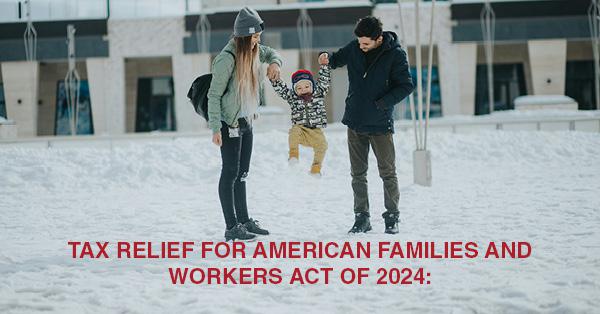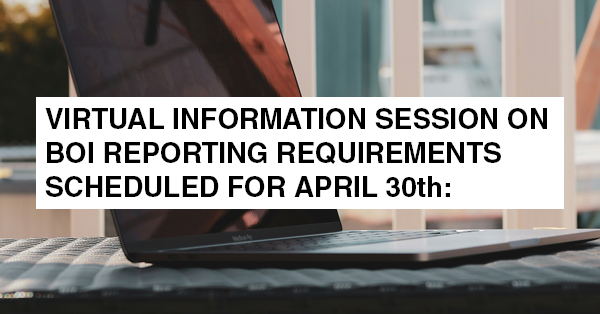TAX RELIEF FOR AMERICAN FAMILIES AND WORKERS ACT OF 2024:

Note from Editor: It is not our policy to introduce proposed legislation, however, this bill has some retroactive provisions that may impact the preparation of 2023 federal income tax returns. This is being presented for information purposes only.
On January 19, 2024, the House of Representatives’ Ways and Means Committee advanced HR 7024, titled “Tax Relief for American Families and Workers Act of 2024,” with a decisive vote of 40-3. This bill represents a consensus reached earlier in the week between Chairman Smith of the Ways and Means Committee and Chairman Wyden of the Senate Finance Committee.
Following are some of the broad provisions of the proposed legislation – note that the legislation proposes closing the window for ERC claims on January 31, 2024 and significantly increasing penalties for fraudulent or criminal ERC claims:
The following changes would be made to the Child Tax Credit under the bill.
- Per-Child Basis Calculation of Maximum Child Tax Credit. The maximum amount of the child tax credit that can be refunded would be determined by multiplying the earned income of the taxpayer exceeding $2,500 by 15% and then multiplying that result by the number of qualifying children. At present, the number of qualifying children does not affect the calculation of the maximum refundable child tax credit. This provision would be in effect from 2023 to 2025. [Act Section 101]
- Aggregate Restriction for Refundable Child Tax Credit: In addition to the aforementioned cap, the maximum reimbursable child tax credit is further bounded by a fixed monetary sum per child, which is currently set at $1,600 per child, as per the existing law. The bill proposes to elevate the maximum reimbursable amount per child to $1,800 for 2023, $1,900 for 2024, and $2,000 in 2025, along with an inflation modification for 2024 and 2025. [Act Section 102]
- Inflation Adjustment. The amount of the child tax credit, which is currently set at $2,000, would be indexed to inflation for the years 2024 and 2025, with the result rounded down to the nearest $100. [Act Section 103]
- Election to Use Prior Year’s Earned Income. Taxpayers will have the opportunity to participate in an election in 2024 and 2025 to utilize the earned income from the preceding year when calculating the child tax credit. This election is available if the taxpayer’s earned income in the current year is lower than the earned income in the previous year. [Act Section 104]
- IRS to Attempt to Automatically Issue Refunds to Early 2023 Filers. The implementation of these proposed legislative amendments, should they be enacted, would occur, at best, several weeks into the year 2024. Consequently, a substantial number of taxpayers, particularly those anticipating a tax refund, will likely file their tax returns before the Internal Revenue Service (IRS) is prepared to process returns claiming the revised Child Tax Credit. In order to address this issue, Section 105 of the Act stipulates that, to the greatest extent feasible, the IRS must recalculate the Child Tax Credit based on the aforementioned amendments and any information provided by the taxpayer. In the event that this recalculation results in a refund, the agency is obligated to issue said refund or credit as expeditiously as possible.
100% Bonus Depreciation to Apply for an Additional Three Years
In accordance with the provisions outlined in the Tax Cuts and Jobs Act, bonus depreciation commenced a phased reduction for the majority of assets placed in service subsequent to December 31, 2022. Specifically, the bonus depreciation amount for 2023 decreased from 100% to 80%. This reduction is scheduled to continue to increase in subsequent years.
In accordance with Section 203 of the Act, bonus depreciation will be maintained at a rate of 100% for assets placed into service by December 31, 2025. Subsequently, the TCJA’s bonus depreciation rate of 20% will be applied to the majority of assets placed in service in 2026, with the exception of long-lived assets. Long-lived assets put into service before January 1, 2027 will retain the benefit of the 100% bonus depreciation rate.
The proposed legislation would be applied retroactively to assets placed in service after December 31, 2022, as specified in Act Section 105(d).
Increase in §179 Expensing Amounts
The proposed legislation outlined in Section 204 of the Act aims to augment the permissible expense deductions for taxpayers under Internal Revenue Code Section 179. Specifically, the proposed legislation seeks to raise the maximum deductible amount for qualifying property in 2024 to $1.29 million. However, it is important to note that this amount will be decreased on a dollar-for-dollar basis by the amount exceeding $3.22 million for qualifying property. Furthermore, these specified amounts will be adjusted for inflation for tax years commencing after December 31, 2023.
Increase in the Threshold Amount for Certain Information Returns
Under Act Section 601(a), the threshold amount would increase from $600 to $1,000 worth of payments made during the calendar year to a subcontractor, independent contractor or certain other payments required to be reported on Forms 1099-MISC and 1099-NEC.
As outlined in Section 601(b) of the Act, the threshold amount will be adjusted annually for inflation for calendar years subsequent to two thousand and twenty-four.
The new threshold amounts would apply to payments made after December 31, 2023 per Act Section 601(f).
COVID-19 Enforcement Provisions
In Section 602 of the Act, Congress has proposed the enactment of significant provisions to be utilized for the enforcement of COVID-19-related Employee Retention Credit (ERC) refund claims. Additionally, the Act mandates that all COVID-19-related ERC refund claims must be submitted no later than January 31, 2024.




